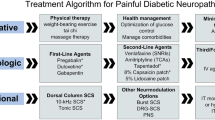Abstract
To evaluate the effect of tiagabine hydrochloride in painful neuropathy in a pilot, open-label study. Painful neuropathy is characterized by preferential involvement of small sensory and autonomic fibers. Tiagabine increases γ-aminobutyric acid and might enhance the central pain-control mechanisms. Seventeen patients (10 men, 7 women; mean age 51.4±7.7 y) with chronic painful neuropathy (>6 months) were enrolled in this study. Week 0:All pain medications were discontinued. Weeks 1–4: Dose of tiagabine was increased weekly by 4 mg orally up to 16 mg in week 4. Quantitative sensory testing for vibration, cooling, and heat-pain, and quantitative sudomotor axon reflex test (QSART) were done at week 0 and week 4. The McGill Pain Questionnaire was administered weekly.
Nine patients completed the study; 8 patients discontinued the treatment. Baseline pain intensity was 6.2±3.1 on the McGill Pain Questionnaire scale (0–10 range). Low doses (4–8 mg) of tiagabine reduced pain symptoms by 16–38%, improving surface pain (37.5%), skin sensitivity (32.8%), burning (38.6%), cold (25.4%) and pain sharpness (29%; p<0.03). Dull and deep pain did not improve. Quantitative sensory testing abnormalities diminished with treatment (p<0.02). Autonomic test results did not change.
This pilot study evaluated the potential of tiagabine hydrochloride (Gabitril) in treatment of painful sensory neuropathy. Pain symptoms and quantitative sensory test results improved with treatment, especially at low doses of tiagabine (4–8 mg). Higher doses (12–16 mg) were associated with increased number of adverse events.
Tiagabine may have potential benefits for treatment of painful neuropathy; however, assessment of its efficacy in a larger study is needed.
Similar content being viewed by others
References
Holland NR, Stocks A, Hauer P, et al. Intraepidermal nerve fiber density in patients with painful sensory neuropathy.Neurology 1997; 48:708–711.
Periquet MI, Novak V, Collins MP, et al. Painful sensory neuropathy. Prospective evaluation using skin biopsy.Neurology 1999; 53:1641–1647.
Novak V, Freimer ML, Kissel JT, et al. Autonomic impairment in painful neuropathy.Neurology 2001; 56:861–868.
Stewart JD, Low PA, Fealey RD. Distal small fiber neuropathy: results of tests of sweating and autonomic cardiovascular reflexes.Muscle Nerve 1992; 15:661–665.
Herrmann DN, Griffin JW, Hauer P, et al. Epidermal nerve fiber density and sural nerve morphometry in peripheral neuropathies.Neurology 1999; 53:1634–1640.
Nicholson B. Gabapentin use in neuropathic pain syndromes.Acta Neurol Scand 2000; 101:359–371.
Harden RN. Gabapentine: a new tool in the treatment of neuropathic pain.Acta Neurol Scand 1999; 173(Suppl):43–47.
Magnus L. Nonepileptic uses of Gabapentin.Epilepsia 1999; 40 (6):S66-S72.
Chaudhry V, Moser HW, Cornblath DR. Nerve conduction studies in adrenomyeloneuropathy.J Neurol Neurosurg Psychiatry 1996; 1996:181–185.
Reading AE. A comparison of the McGill Pain questionnaire in chronic and acute pain.Pain 1982; 13(2):185–192.
Low PA. Autonomic nervous system function [Review].J Clin Neurophysiol 1993; 10(1):14–27.
Low PA. Laboratory evaluation of autonomic function. In:Clinical autonomic disorders. Low PA, ed. Philadelphia: Lippincott-Raven; 1997. pp. 179–208.
Low PA. Non-invasive evaluation of autonomic function.Neurology Chronicle 1992; 2:1–8.
Low PA. Evaluation of autonomic function [Review].CO Neurol Neurosurg 1992; 5(4):461–463.
Dyck PJ, Karmes J, O'Brien PC, et al. Detection thresholds of cutaneous sensations in humans. In:Peripheral neuropathy. Dyck PJ, Thomas PK, Griffin JW, et al., eds. Philadelphia: Saunders; 1993. pp. 706–728.
Max MB. Thirteen consecutive well-designed randomized trials show that antidepressants reduced pain in diabetic neuropathy and postherpetic neuralgia.Pain Forum 1995; 4:248–253.
Kingerly WS. A critical review of controlled clinical trials for peripheral neuropathic pain and complex regional pain syndromes.Pain 1997; 73:123–139.
Schachter SC. A review of the antiepileptic drug tiagabine.Clin Neuropharmacol 1999; 22(6):312–317.
Ipponi A, Lamberti C, Medica A, et al. Tiagabine antinociception in rodents depends on GABA(B) receptor activation: parallel antinoception testing and medial thalamus GABA microdialysis.Eur J Pharmacol 1999; 368(2–3):205–211.
Werhahn KJ, Kunesch E, Noachtar S, et al. Differential effects on motorcortical inhibition induced by blockade of GABA uptake in humans.J Physiol 1999; 517(2):591–597.
Eriksson IS, Allard P, Marcusson J. [3H] tiagabine binding to GABA uptake sites in human brain.Brain Res 1999; 18(1–2):183–188.
Luer MS, Rhoney DH. Tiagabine: a novel antiepileptic drug.Annals Pharmacotherapy 1998; 32(11):1173–1180.
Mao J, Chen LL. Gabapentine in Pain management.Anesth Analg 2000; 91:681–687.
Schmidt D, Gram L, Brodie M, et al. Tiagabine in the treatment of epilepsy—a clinical review with a guide for the prescribing physician.Epilepsy Res 2000; 41(3):245–251.
Schmitt U, Luddes H, Hiemke C. Behavioral effects of GABA(A) receptor stimulation and GABA-transporter inhibition.Pharmacol Biochem Behav 2000; 65(2):351–356.
Author information
Authors and Affiliations
Corresponding author
Additional information
This study was sponsored by a grant from Abbott Laboratories and Cephalon, Inc., Westchester, PA, U.S.A.
Rights and permissions
About this article
Cite this article
Novak, V., Kanard, R., Kissel, J.T. et al. Treatment of painful sensory neuropathy with tiagabine: A pilot study. Clinical Autonomic Research 11, 357–361 (2001). https://doi.org/10.1007/BF02292767
Received:
Accepted:
Issue Date:
DOI: https://doi.org/10.1007/BF02292767




